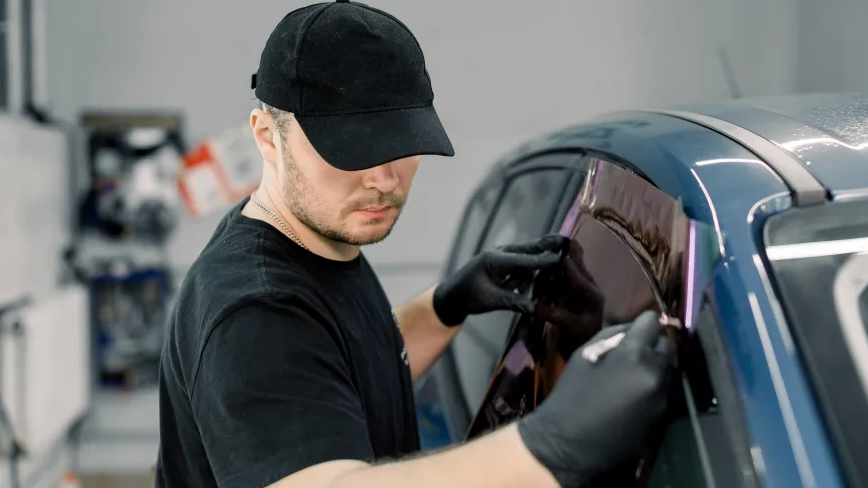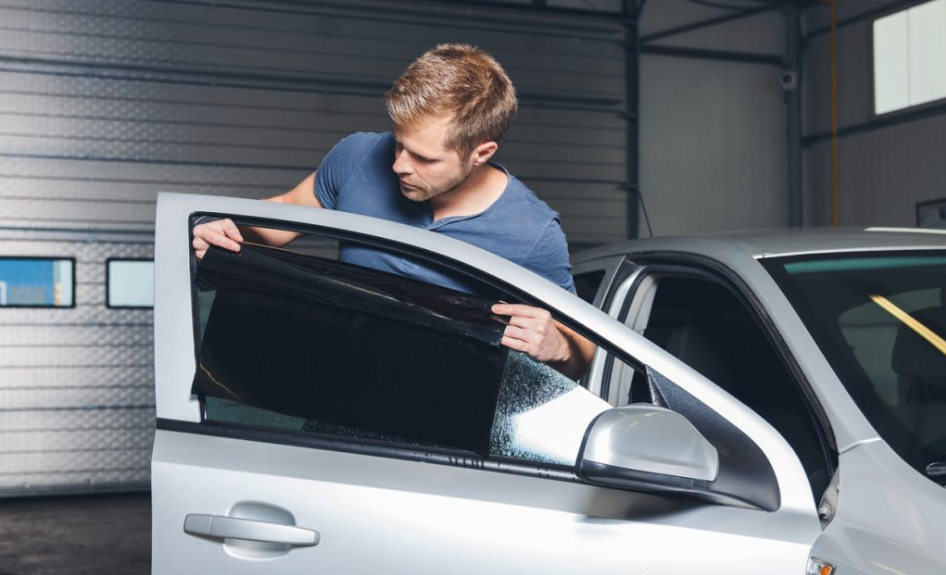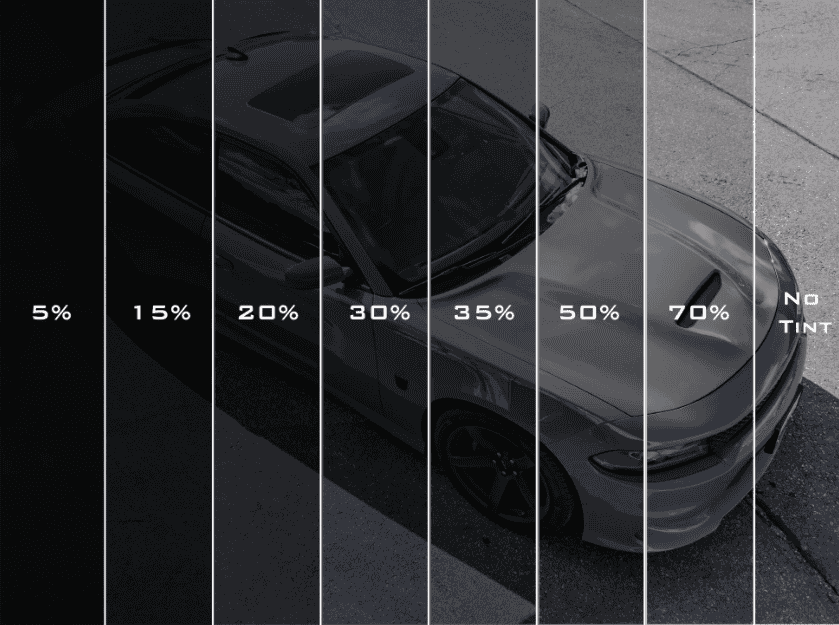Business
How Much Does It Cost to Tint Car Windows?

Tinting car windows has become a popular modification among vehicle owners. Whether for privacy, protection from the sun, or to enhance the car’s appearance, tinted windows offer a range of benefits. However, a common question among drivers is: how much does it cost to tint car windows? The answer varies depending on several factors, from the type of film used to the size and type of vehicle.
This article will provide a comprehensive breakdown of the costs associated with window tinting, the advantages and disadvantages of getting your windows tinted, and everything in between.
Factors Affecting the Cost of Car Window Tinting
- Type of Vehicle
The size and shape of your car play a big role in determining the price. Larger vehicles like SUVs, trucks, and vans will generally cost more to tint than smaller sedans or coupes. This is due to the increased surface area of the windows and sometimes the complexity of the curves on the vehicle’s glass. - Type of Tinting Film
Different types of window tint films are available, ranging from standard dyed film to ceramic tint and high-performance films. Below are some common options:- Dyed film: This is the most basic and affordable option, providing a dark appearance but offering less heat and UV protection. Costs range from $100 to $300 for a full vehicle.
- Metalized film: Offers better heat rejection and UV protection, with prices typically ranging from $200 to $500.
- Ceramic film: The premium option, offers superior heat rejection, UV protection, and glare reduction. Prices range from $300 to $800 or more.
- Carbon film: Offers fade resistance and excellent durability, usually priced between $200 and $600.
- Number of Windows
The more windows you tint, the higher the cost. Tinting all the windows, including the rear windshield and the side windows, can increase the price significantly. If you only tint the front two windows, the cost will be lower. - Quality of Installation
Professional installation can make a huge difference in the quality and longevity of the tint job. A reputable installer may charge more, but you’re likely to get better results compared to a cheaper service. Professional installations usually come with warranties, adding peace of mind.
DIY tinting kits, on the other hand, can cost as little as $50 to $100, but the results may not be as polished, and mistakes can be difficult to correct. - Location
Prices can vary based on the region. For instance, tinting services in urban areas or places with a high demand for window tinting (like sunny states such as California or Florida) may be more expensive than in rural areas.

Average Costs Based on Vehicle Type
- Sedan: Tinting a sedan’s windows typically costs between $100 and $400, depending on the quality of the tint and whether you choose to tint all the windows or just a few.
- SUVs and Trucks: These vehicles cost more to tint, with prices ranging from $150 to $600. Larger windows and more glass surface area contribute to the higher price.
- Luxury Vehicles: Tinting for luxury cars may range from $300 to $800 due to complex window shapes and the need for specialized films.
Benefits of Car Window Tinting
- UV Protection
One of the primary reasons people tint their car windows is to block harmful UV rays. Many films block up to 99% of UV radiation, which can help protect both the vehicle’s interior and the driver’s skin. - Temperature Control
High-quality tints, especially ceramic films, can significantly reduce heat inside the vehicle by up to 60%. This keeps your car cooler, reduces the need for air conditioning, and improves fuel efficiency. - Privacy and Security
Darkened windows add privacy by preventing others from easily seeing inside your vehicle. This can also help reduce the risk of theft by keeping valuables out of sight. - Enhanced Aesthetics
Window tinting can give your car a sleek, modern appearance. Many people opt for tinting simply to improve their vehicle’s overall look. - Shatter Protection
In the event of an accident, window tinting film can help hold shattered glass together, reducing the risk of injury from flying glass shards.
Drawbacks of Car Window Tinting
- Legal Restrictions
Window tint laws vary from state to state, and in some cases, from county to county. Darker tints may not be legal in certain areas, particularly on the front windows or windshield. You can be fined or required to remove the tint if it doesn’t comply with local regulations. Make sure to check local laws before getting your windows tinted. - Cost
High-quality tints, especially ceramic or metalized films, can be expensive. Some drivers may find the cost prohibitive, particularly if they’re only interested in the aesthetic benefits. - Maintenance
While window tint film is generally durable, it requires proper care. You must avoid using abrasive cleaners or sharp objects that can scratch the film. Over time, cheaper films may bubble, fade, or peel, necessitating costly replacements. - Reduced Visibility at Night
Darker tints, especially on the rear windows, can reduce visibility during night driving. This can be a safety concern, particularly for drivers who already have difficulty seeing in low-light conditions.

FAQs About Car Window Tinting
- Is window tinting worth the cost? Yes, window tinting is worth it for many vehicle owners due to its benefits, including UV protection, temperature control, and enhanced privacy. It can also help improve your car’s aesthetic appeal.
- What is the darkest legal tint? The darkest legal tint varies by state or country. For instance, many states in the U.S. allow 35% light transmission on front side windows, but the rear windows can be darker. Always check your local laws before tinting.
- How long does window tint last? Quality window tints can last between 5 and 10 years, depending on the type of film and how well it’s maintained. Ceramic tints tend to have the longest lifespan.
- Can I wash my car after tinting the windows? It’s recommended to wait 3 to 7 days after installation before washing the car. This allows the tint to fully cure.
- Does window tint affect visibility? Darker tints can affect visibility, especially at night. To maintain safety, avoid extremely dark tints on windows where visibility is crucial.
Conclusion
Window tinting is an investment in your car that offers both functional and aesthetic benefits. While the cost to tint car windows can vary based on vehicle type, film quality, and location, it is an enhancement that improves your comfort, privacy, and safety on the road. However, it’s essential to weigh the pros and cons and ensure compliance with local laws before making the decision to tint your windows.
By choosing the right type of film and professional installation, you can enjoy all the benefits of tinted windows for years to come. Whether you’re interested in blocking UV rays, keeping your car cooler, or just adding a sleek look to your vehicle, window tinting is a popular and worthwhile modification.
For more, Visit Bussines Radar
Business
Office Desks and Mental Well-being: How Workspace Design Impacts Employee Morale

In the modern workplace, the design of office spaces, particularly the office furniture, plays a crucial role in fostering an environment that promotes productivity and mental well-being. With employees spending a significant amount of time at their desks, how these workspaces are organised and equipped can greatly influence both their physical comfort and their psychological state.
Office desks, as a central component of the work environment, are not just functional surfaces to complete tasks; they are powerful tools in shaping the overall experience of the workplace. From ergonomic designs to the arrangement of personal space, the physical layout of an office is deeply intertwined with the mental well-being of its occupants. But it’s not just about comfort—workspace design also impacts employee morale, motivation, and job satisfaction.
In this article, we will explore the connection between office desk design, office furniture choices, and employee mental health, while providing insights into how thoughtful design can create an atmosphere conducive to well-being and positive morale.
The Importance of Ergonomics in Office Desk Design
When considering office desks, one of the most important aspects to address is ergonomics. Ergonomically designed office furniture helps to minimise physical strain on employees, reducing the risk of injury and improving comfort. A well-designed desk allows employees to work efficiently without putting unnecessary pressure on their bodies, which in turn can enhance their mental state.
For instance, a desk that promotes proper posture helps to avoid discomfort such as back and neck pain, which can be distracting and mentally exhausting. In contrast, a poorly designed desk can cause repetitive stress injuries or chronic pain, leading to increased absenteeism and decreased job satisfaction. The impact of discomfort goes beyond physical health; it directly affects mental well-being by creating a stressful, distracting work environment.
Moreover, ergonomic office furniture such as chairs with adjustable armrests, desks with the right height, and monitor stands that align with eye level contribute to a comfortable working environment that encourages better focus. Employees are likely to feel more valued and cared for when their employer invests in furniture that supports their well-being, boosting morale and overall happiness.
The Psychological Effects of Workspace Layout and Design
The arrangement of office desks and furniture within a workspace can have a significant psychological impact. For example, a cluttered or disorganised office may increase stress levels, while a thoughtfully designed, organised space can reduce anxiety and promote a sense of calm.
Open-plan offices, which have become increasingly popular, can have mixed effects on employees. While they foster collaboration and communication, they can also lead to distractions and feelings of being overwhelmed due to lack of privacy. A well-balanced workspace layout—where desks are arranged to encourage both collaboration and privacy—can help employees feel more in control and comfortable in their work environment, thus promoting mental well-being.
On the other hand, personalisation of workspaces is another key element in the mental health equation. Allowing employees to personalise their desks, with items such as plants, family photos, or artwork, can foster a sense of ownership and connection to their space. This simple act of making the workspace their own can significantly boost employee morale and create a positive atmosphere.
Colour, Light, and Environmental Factors: Setting the Right Mood
When discussing the impact of office desks and furniture on mental well-being, we must also consider the environmental factors of the workspace. Lighting, colour schemes, and overall aesthetics can greatly affect an individual’s mood and productivity.
Natural light, in particular, is known to have a positive impact on mental health. Exposure to natural light helps regulate the body’s internal clock and improve sleep quality, both of which are critical for maintaining mental well-being. Office desks positioned near windows can significantly improve the overall work experience by allowing employees to enjoy daylight and the benefits it brings.
Colour also plays an essential role in shaping the mood of a workspace. Studies have shown that certain colours can influence productivity and mental health. For example, shades of blue and green have been linked to increased concentration and reduced stress, while warmer tones such as orange and yellow can boost energy and creativity. Choosing the right colours for the office walls, furniture, and accessories, including office desks, is a subtle yet powerful way to improve employee morale.
Moreover, the use of plants in the office can promote a sense of calm and well-being. Integrating greenery into office spaces not only enhances the aesthetics but also improves air quality and reduces stress. Desk plants or even large plants placed around the office can create a natural, peaceful environment, helping employees feel more relaxed and motivated.
Flexibility and Adaptability: Encouraging Employee Autonomy
The ability to adapt one’s workspace to suit individual needs is another important factor in supporting employee mental health. Desks that are flexible and allow for adjustments—such as sit-stand desks or those with adjustable heights—provide employees with the autonomy to tailor their work environment according to their physical comfort. The option to switch between sitting and standing can reduce the risk of health problems associated with sedentary work, such as poor posture or back pain.
Flexible workspaces also allow employees to change their surroundings when needed, which can help combat feelings of monotony and burnout. The sense of control over one’s environment can enhance employee satisfaction, leading to improved morale and a more positive attitude toward work.
Creating a Positive Work Environment: Beyond the Office Desk
While office desks and furniture are integral to creating a supportive and positive workspace, there are other elements that contribute to employee morale and mental well-being. For instance, access to quiet spaces for reflection or relaxation, as well as opportunities for social interaction, can have a profound impact on an employee’s state of mind.
Providing a variety of spaces within the office—such as breakout areas, lounge spaces, or quiet rooms—can encourage employees to take breaks and recharge. Mental well-being isn’t just about physical comfort but also the emotional and social aspects of work life. Encouraging positive social interaction and offering moments of rest away from the desk can boost overall morale and create a healthier work environment.
Furthermore, when employees feel that their workplace is designed with their needs in mind, it strengthens the relationship between employer and employee. Providing a well-thought-out office space can communicate to employees that they are valued, which can improve morale, loyalty, and productivity.
Conclusion
In conclusion, the design of office desks and the surrounding furniture can significantly impact employee mental well-being and morale. From ergonomic furniture that prevents physical discomfort to layouts that promote a positive atmosphere, the way an office is organised influences not only the physical comfort of employees but also their mental state and overall job satisfaction.
Investing in quality office furniture and designing spaces that promote autonomy, flexibility, and comfort can have a profound effect on employees’ mental health. By thoughtfully considering these aspects, employers can create an environment where employees feel valued, supported, and motivated, leading to improved morale and better productivity.
Business
Stanford Markets.com Review – Can It Be Trusted or Is It a Scam?

In this Stanford-Markets.com review, traders will explore the platform’s access to global markets, which allows users to trade across a variety of asset classes. Whether looking to trade stocks, forex, cryptocurrencies, or commodities, Stanford Markets provides an extensive range of options for traders around the world. This comprehensive access empowers users to diversify their portfolios and engage with international markets with ease.
Stanford Markets stands out by offering a seamless trading experience across multiple platforms, ensuring that clients have the tools they need to navigate the financial landscape. Whether through desktop, web, or mobile, the platform’s user-friendly interface and cutting-edge technology support traders of all levels. With real-time market analysis and advanced charting tools, Stanford Markets equips its users with the necessary resources to stay informed and make strategic trading decisions. This Stanford-Markets.com review will provide deeper insight into how this global access can benefit traders and why Stanford Markets remains a popular choice for those seeking a versatile trading environment.
Access Markets Worldwide with One Account
With access to multiple global markets through a single account, Stanford Markets traders are empowered to explore a vast range of opportunities. Gone are the days of managing several accounts with different brokers or facing limitations on the markets that can be traded. This platform allows individuals to trade in major financial hubs across the globe, including the U.S., Europe, Asia, and emerging markets.
By providing worldwide access through a single account, the Stanford Markets platform opens up the opportunity for traders to capitalize on trends and opportunities wherever they arise. Whether it’s trading stocks on the New York Stock Exchange, engaging in forex trading, or exploring commodities in markets like London or Tokyo, traders can easily navigate the complexities of each without the need for multiple logins or platforms. This centralization of accounts streamlines the trading experience, saving time and reducing the complexity of managing multiple accounts for different asset classes.
Trade Across Multiple Asset Classes Seamlessly
One of the biggest benefits of the Stanford Markets platform is its ability to trade across multiple asset classes without any barriers or limitations. Traders no longer need to worry about being restricted to one specific market or asset type. From forex to commodities, indices, stocks, and cryptocurrencies, the platform supports a wide variety of trading instruments, giving users the ability to diversify their portfolios with ease. The seamless transition between these different asset classes helps traders execute strategies more effectively, regardless of the market conditions or their area of expertise.
Trading across multiple asset classes also allows traders to take advantage of opportunities in different sectors. If one market is volatile, another might be more stable, providing balance and risk mitigation. With the tools provided, such as advanced charting and real-time market analysis, traders can monitor their investments in multiple asset classes at once and make decisions based on up-to-date information.
Expanding Your Portfolio with Global Trading
Expanding a portfolio is made easier when traders have access to global markets with just one account. The platform allows traders to branch out into international markets, which is critical for reducing risk and maximizing potential returns. A diversified portfolio that spans various geographic regions and asset classes can weather market fluctuations more effectively than one concentrated in a single region or sector.
Global trading also offers the benefit of hedging against domestic market downturns. If one country or market experiences economic instability, traders can adjust their strategies by focusing on other global markets with more favorable conditions. This international reach allows for strategic decision-making that can adapt to different economic cycles and trends. Furthermore, the ease of trading foreign stocks, commodities, and currencies provides access to new growth opportunities that might not be available in local markets.
Why Global Market Access is a Game Changer
Global market access is undoubtedly a game changer for traders who are looking to stay ahead in the competitive world of investing. It offers an unparalleled level of flexibility, allowing traders to follow global trends and diversify their investments in a way that was once difficult or impossible with traditional brokerage firms. The ability to trade in multiple markets across different time zones also means that traders can operate virtually around the clock, reacting to global events as they happen, rather than being limited to the typical 9-to-5 trading hours of a single market.
Additionally, global market access opens up opportunities that might have previously been out of reach for individual traders. Emerging markets, international stocks, and global commodities can all be incorporated into a portfolio, adding a layer of growth and profitability that is hard to achieve in more localized trading environments. Stanford Markets traders who can tap into the dynamics of different economies and global events are often in a better position to make informed decisions that yield higher returns.
A Unified Platform for Stock, Forex, and Crypto Trading
A unified platform that offers stock, forex, and crypto trading in one place provides traders with a streamlined and integrated trading experience. By eliminating the need for multiple platforms or accounts, traders are able to manage their entire portfolio from a single dashboard. This makes it easier to track performance, monitor changes, and execute trades quickly. With features like real-time market updates and customizable charts, traders can keep an eye on all asset classes in a way that enhances their decision-making process.
Moreover, the ability to trade across stocks, forex, and cryptocurrencies from the same Stanford Markets platform enables traders to leverage opportunities across all these different markets. While stock trading might be focused on longer-term investments, forex trading offers opportunities for short-term gains, and crypto trading opens up new, high-growth opportunities in a rapidly evolving sector.
Conclusion of the Stanford-Markets.com Review
In conclusion, the Stanford-Markets.com review highlights the significant advantages of using a single platform to access global markets and trade across multiple asset classes. The ability to seamlessly trade stocks, forex, and cryptocurrencies from one account allows traders to diversify their portfolios and stay ahead of market trends with ease. Whether it’s expanding investments into international markets or leveraging advanced tools for more informed decision-making, Stanford Markets provides the flexibility and resources needed to succeed in today’s dynamic trading environment.
Furthermore, the Stanford-Markets.com review underscores the importance of a unified platform that simplifies the trading process, reducing the complexities typically associated with managing multiple accounts. By offering real-time analysis, customizable charts, and flexible trading options, the platform enables traders to adapt their strategies based on global market movements and diverse asset classes. For those seeking to enhance their trading experience and capitalize on global opportunities, the platform offers a comprehensive solution.
This article is provided for informational purposes only and is not intended as a recommendation. The author disclaims any responsibility for the company’s actions in the course of your trading activities. It’s important to understand that the information presented in this article may not be entirely accurate or current. Your trading and financial decisions are your own responsibility, and it is vital not to rely solely on the content provided here. We make no warranties about the accuracy of the information on this platform and disclaim any liability for losses or damages arising from your trading or investment decisions.
For More, Click Business Radar
Business
Exploring the Life of Evan Whitesell: Lauren Sánchez’s Son

Evan Whitesell, the son of media personality Lauren Sánchez and Hollywood agent Patrick Whitesell, has lived a life largely out of the public eye despite his family’s high-profile status. While his mother is recognized for her media career and personal life, and his father is a titan in the entertainment industry, Evan’s story is one of navigating life in the shadows of fame.
A Peek into Evan Whitesell’s Family Legacy and Background
Evan Whitesell was born into a family with deep ties to the entertainment industry. His mother, Lauren Sánchez, is a celebrated journalist, entrepreneur, and the founder of Black Ops Aviation, a film production company specializing in aerial shots. She has also been in the spotlight for her relationship with Jeff Bezos, one of the world’s richest individuals.
Evan’s father, Patrick Whitesell, is a co-CEO of WME (William Morris Endeavor), a leading talent agency. His work with Hollywood’s elite actors and directors has cemented his position as one of the most influential figures in the entertainment business.
Evan also has two siblings: a brother, Nikko González, from Lauren’s previous relationship with retired NFL player Tony González, and a younger sister, Eleanor Patricia Whitesell, from Lauren and Patrick’s marriage. The unique blend of talent, business acumen, and celebrity in Evan’s family has created an environment where ambition and success are strongly emphasized.
Evan Whitesell’s Age and Early Life
While specific details about Evan Whitesell’s age and early upbringing are scarce, he was likely born in the mid-2000s, making him a teenager today. Growing up with parents deeply entrenched in the media and entertainment industries has likely influenced Evan’s worldview and opportunities.
His early years were spent in Los Angeles, surrounded by luxury and privilege. However, despite his family’s high profile, his parents have maintained a level of privacy for their children. Evan’s life is characterized by a mix of public curiosity and personal discretion, ensuring he is shielded from unnecessary scrutiny while still benefiting from his family’s status.

The Role of Family Influence in Shaping Evan’s Path
Coming from a family with such high achievements, Evan Whitesell’s upbringing has been heavily shaped by his parents’ values and accomplishments. Lauren Sánchez’s focus on entrepreneurial ventures, coupled with Patrick Whitesell’s success as an agent, likely instilled in Evan an appreciation for hard work, innovation, and ambition.
Evan’s older brother Nikko González has carved his own path, excelling in sports and academics, which may serve as additional motivation for Evan to achieve success in his chosen field. The Whitesell family dynamic is one of mentorship and mutual support, offering Evan a solid foundation as he navigates his life and career choices.
What Career Path Might Evan Whitesell Pursue?
As of now, Evan Whitesell has not publicly announced his career interests or pursuits, but his background and family connections have opened many doors. With a mother skilled in journalism, entertainment, and aerial filming, and a father leading one of Hollywood’s most powerful agencies, Evan has exposure to a wide array of professional avenues.
If Evan follows in the footsteps of his parents, he might venture into media, film production, or business management. Alternatively, he could carve his own path in a completely unrelated field, as seen with many celebrity children who seek to define their identity away from their parents’ legacies.
Evan Whitesell’s Relationship with His Siblings
Evan shares a close bond with his siblings, Nikko González and Eleanor Patricia Whitesell. The sibling dynamic within the Sánchez-Whitesell family reflects a blend of shared experiences and individual growth.
Nikko, being the eldest, often takes on a role of leadership, especially as he forges his own path in sports. Meanwhile, Eleanor, the youngest, enjoys a different level of attention and protection from the family. Evan’s place as the middle child allows him to draw from the examples set by Nikko and to act as a role model for Eleanor.
This supportive and nurturing environment ensures that Evan has both guidance and the freedom to explore his individuality.
The Public’s Curiosity About Evan Whitesell’s Private Life
Despite the fame of his parents, Evan Whitesell has remained largely out of the limelight, reflecting his family’s efforts to ensure their children grow up with a sense of normalcy. Unlike other celebrity children who often find themselves in the public eye from a young age, Evan’s life has been kept relatively private.
This discretion might be attributed to the values upheld by Lauren Sánchez and Patrick Whitesell, who prioritize the well-being of their children over media exposure. However, the public’s curiosity about Evan remains high, especially given his unique position within a family of achievers.
Conclusion
Evan Whitesell is a young man with an exceptional family background, poised for a bright future. The blend of ambition, talent, and opportunity within his family provides a platform for him to succeed, whether he follows in his parents’ footsteps or forges his own path.
As Evan grows older, his life will undoubtedly continue to draw attention, especially as he begins to explore his interests and career ambitions. Until then, he remains an intriguing figure whose story highlights the complexities of growing up in a high-profile family.
FAQs
Who are Evan Whitesell’s parents?
Evan Whitesell’s parents are Lauren Sánchez, a journalist and entrepreneur, and Patrick Whitesell, co-CEO of WME.
Does Evan Whitesell have any siblings?
Yes, Evan has an older half-brother, Nikko González, and a younger sister, Eleanor Patricia Whitesell.
What is Evan Whitesell’s age?
Evan is likely in his teenage years, though his exact age has not been disclosed.
What career path will Evan Whitesell pursue?
While it is not yet known, Evan’s background provides opportunities in media, entertainment, or entirely different fields.
Why is Evan Whitesell kept out of the spotlight?
Evan’s parents prioritize their children’s privacy, ensuring they grow up with a sense of normalcy despite the family’s high profile.
What is Lauren Sánchez known for?
Lauren Sánchez is known for her career as a journalist, entrepreneur, and the founder of Black Ops Aviation, as well as her relationship with Amazon founder Jeff Bezos.
-

 Celebrity5 months ago
Celebrity5 months agoBailey Zimmerman’s Net Worth in 2024: A Look at His Earnings
-

 Business7 months ago
Business7 months agoIs Bolt Cheaper Than Uber? Comparing Ride-Hailing Prices and Services
-

 Celebrity6 months ago
Celebrity6 months agoWho Is Charlotte Tilbury: The Visionary Behind a Global Beauty Empire
-

 Celebrity6 months ago
Celebrity6 months agoJohn Summit Net Worth: A Rising Star in the Music Industry
-

 Celebrity4 months ago
Celebrity4 months agoExploring the Life of Andrew Shingange: Trevor Noah’s Brother and an Advocate for Change
-

 Celebrity4 months ago
Celebrity4 months agoCaseOh’s Financial Success in 2024: Net Worth, Income Streams & More
-

 Celebrity5 months ago
Celebrity5 months agoWho Is Josh Winterhalt? All About His Net Worth, Wife Sarah Wayne Callies, and Marriage
-

 Celebrity5 months ago
Celebrity5 months agoJamie Apody Net Worth, Biography, Age, Husband, and Career Journey



